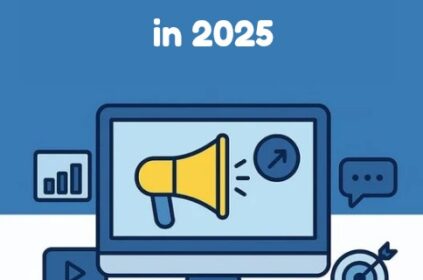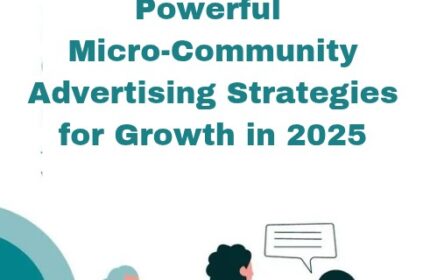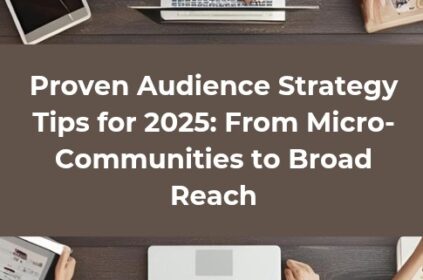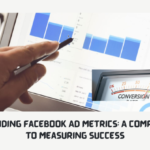Do you ever get the sense that your current marketing strategy isn’t quite hitting the right notes? While social media advertising remains a powerful tool, perhaps you’re looking to expand your reach and connect with audiences in a fresh, engaging way. If you’re seeking innovative marketing avenues to complement your existing strategy, podcast advertising might be the perfect addition to your mix.
Did you know that there are over 464 million podcast listeners worldwide, which is projected to reach 504.9 million by 2024? (Source: Backlinko) The podcasting landscape has exploded in recent years. With millions tuning in for their daily dose of informative and entertaining audio content, podcasts have become a powerful platform for businesses to reach highly targeted audiences.
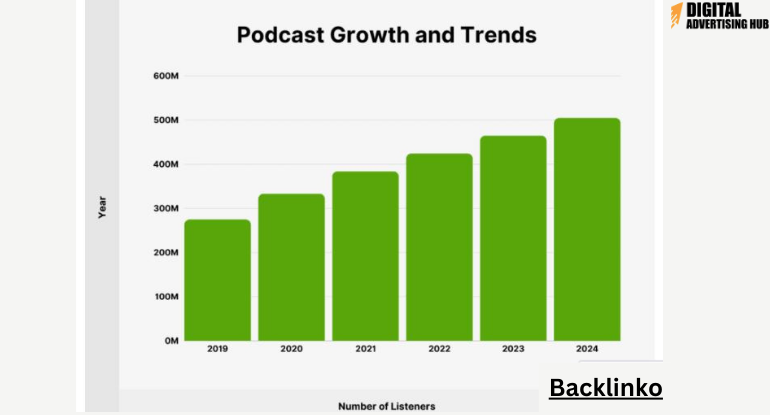
In this comprehensive guide, we will explore the world of podcast advertising with practical explanation, equipping you with the right knowledge to strategize, launch, and measure successful campaigns.
Whether you’re a seasoned digital marketer or a business owner just starting to explore new marketing channels, this guide will show you how to leverage the power of podcasts to achieve your organizational goals and propel your brand forward.
We will navigate the different ad formats, explore strategies for targeting the perfect audience, and equip you with the tools to craft compelling ads that resonate with listeners. We will also delve into the measurement side of things, helping you track your campaign’s performance and ensure you’re getting the most out of your investment.
So, grab your headphones and get ready to learn how to tap into the engaged world of podcast listeners!
How Does Podcast Advertising Work?
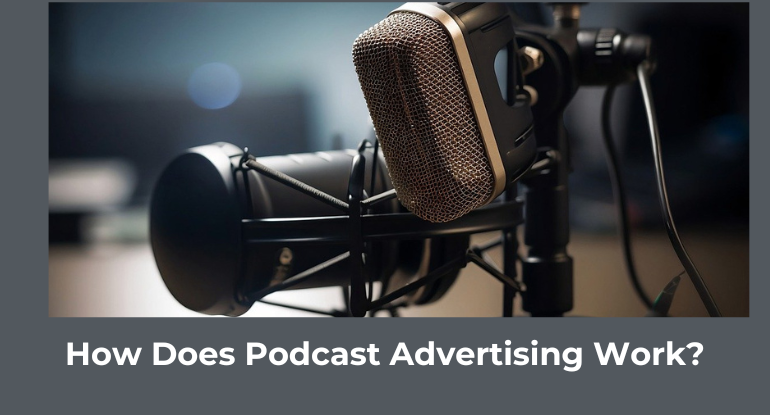
Podcast advertising offers a unique opportunity to connect with a captive audience actively seeking information and entertainment. Unlike traditional advertising methods that can feel intrusive, podcast ads are often seamlessly woven into the listening experience. To leverage this power effectively, let’s dissect the mechanics of podcast advertising and explore the key benefits it offers in detail.
Imagine your target audience engrossed in their favorite true-crime podcast episode. Suddenly, the host, a trusted voice in the genre, takes a moment to introduce a new sponsor.
This sponsor, a company specializing in home security systems, delivers a concise and informative message about their services within the 60-second mid-roll ad slot. This scenario exemplifies the core of podcast advertising: targeted messages delivered during natural breaks in the podcast episode.
There are three main placements for these ads, each with its own strategic advantages:
#1. Pre-roll Ads: These ads play at the very beginning of an episode, before the host welcomes the audience. They’re ideal for grabbing attention and creating a lasting impression, but listeners might not be fully engaged yet.
#2. Mid-roll Ads: Strategically inserted within the episode, typically during natural breaks in the conversation or between segments, mid-roll ads offer a more integrated listening experience. Hosts can even introduce the ad, creating a smoother transition and potentially boosting listener receptiveness.
#3. Post-roll Ads: Play at the conclusion of the episode, reminding listeners about your message as they wrap up. While these ads might have slightly less impact than mid-rolls, they can still be effective for reinforcing your brand or call to action.
Dynamic ad insertion takes this a step further. Imagine you’re advertising a language learning app. This technology allows the podcast platform to identify listeners interested in language learning and serve them your ad during a relevant podcast, even if it wasn’t directly targeted by the show itself.
This ensures the message reaches the most relevant audience segment, maximizing your advertising spend.
For payment, podcast advertising utilizes various cost models. CPM (Cost Per Mille) refers to the cost associated with reaching every thousand listeners. This model is beneficial for brand awareness campaigns where a broad reach is desired.
Alternatively, CPA (Cost Per Action) charges advertisers only when a desired action is taken, such as a website visit or a purchase using a unique discount code. This model is ideal for driving specific conversions and measuring the effectiveness of your ad in generating sales or leads.
Is Podcast Advertising Effective?

Now that we understand the mechanics, let’s delve into the compelling advantages podcast advertising offers:
#1. Highly Targeted Audience Demographics: Unlike mass media advertising, podcasts often cater to specific niches and interests. Imagine you’re promoting a new line of organic skincare products.
Podcast advertising allows you to target beauty and wellness shows, reaching individuals most likely to be interested in your offerings. This laser focus ensures your message resonates with the right audience, maximizing your return on investment.
#2. Engaged Listeners with High Attention Spans: Unlike some forms of advertising that compete with distractions, podcast listeners are actively engaged with the content. They’re typically multitasking with activities that don’t demand their full attention, like exercising or commuting.
This creates a captive audience where your message has a higher chance of being heard and remembered compared to, say, a fleeting banner ad.
#3. Credibility Boost through Host Endorsements: When a trusted podcast host personally vouches for your product or service, it builds instant credibility and trust with listeners. This endorsement effect can significantly influence purchasing decisions.
Imagine a popular fitness podcast host raving about your new protein powder after using it themselves. This personal touch carries more weight than a traditional commercial and can be a powerful marketing tool.
#4. Measurable Results and Campaign Tracking: Unlike traditional advertising channels, podcast advertising provides clear metrics to track your campaign’s effectiveness.
Most podcast platforms and ad networks offer analytics dashboards where you can analyze impressions (the number of times your ad is played), clicks (the number of times listeners take action on your call to action), and even conversions (the number of website sales or sign-ups generated by your ad).
This data allows you to optimize your strategy for maximum return on investment. By analyzing which shows and ad placements generate the most clicks and conversions, you can refine your targeting and ensure your budget is spent effectively.
#5. Cost-Effective Compared to Traditional Advertising: Podcast advertising can be a more cost-effective way to reach a targeted audience compared to traditional advertising methods like television or print media.
While costs can vary depending on the popularity of the podcast and the length of the ad, podcast advertising often offers a lower cost per thousand impressions (CPM) compared to other channels.
#6. Long Shelf Life for Ads: Unlike some ephemeral advertising formats, podcast ads can have a long shelf life. Many listeners binge past episodes of their favorite shows, meaning your ad can reach new listeners even after the initial airing. This extends the value of your investment.
#7. Subscription-Based Listening Model Fosters Loyalty: Podcast listeners who subscribe to shows demonstrate a higher level of engagement with the content compared to passive listeners of other media. This loyalty translates to a higher likelihood of them paying attention to and being receptive to advertising messages within the podcast.
#8. Improves Brand Storytelling: Podcast advertising offer a platform for richer storytelling compared to traditional advertising formats. You can craft a compelling narrative that showcases your brand values, product benefits, and customer stories. This deeper connection with listeners can foster brand loyalty and emotional attachment.
#9. Access to a Global Audience: Podcasts transcend geographical boundaries. With the power of the internet, your message can reach listeners around the world, opening doors to new markets and potential customers.
By harnessing these advantages, podcast advertising can become a powerful tool for businesses looking to expand their reach, build brand awareness, and ultimately drive sales.
Planning Your Podcast Advertising Strategy: Craft a Roadmap to Success

Now that you’re armed with a solid understanding of podcast advertising, it’s time to translate theory into action. This section will guide you through the strategic planning process, ensuring your podcast advertising campaign is targeted, efficient, and delivers the desired results.
Defining Your Goals & Target Audience
Before diving headfirst into the vast world of podcasts, take a step back and define your overarching goals. Here’s where a little introspection goes a long way. Ask yourself:
1. What do I want to achieve with this podcast advertising campaign?
There are several key objectives you might be aiming for:
i). Boost Brand Awareness: Are you a new business or a startup looking to establish your brand in the marketplace? Podcast advertising can be a great way to get your name out there and position yourself as a thought leader in your industry.
For example, imagine you run a company specializing in sustainable home cleaning products. Your goal might be to increase brand awareness among eco-conscious consumers.
ii). Drive Website Traffic & Generate Leads: Do you have a fantastic website or landing page packed with valuable information or offering a free downloadable resource? Podcast advertising can be a powerful tool to drive targeted traffic to your website and capture leads through strategic calls to action within your ad.
For example, a financial planning firm might utilize podcast advertising to promote a free consultation for listeners interested in personalized retirement planning advice. Their ad could include a unique discount code or URL mentioned by the host, allowing them to track website traffic generated by the campaign.
iii). Increase Sales & Conversions: Are you looking to directly boost sales of your product or service? Podcast advertising can be highly effective in driving conversions, especially when combined with a compelling offer and a clear call to action.
For example, an online language learning app might partner with a popular language learning podcast to promote a special discount on their subscription plans. Their ad could feature a limited-time promo code listeners can use at checkout, allowing them to measure the campaign’s direct impact on sales.
Having clear goals allows you to tailor your campaign and measure its success effectively. Imagine setting a goal of “increasing website traffic” – this is a good start, but to measure success, you’ll need a specific target. Perhaps you aim for a 20% increase in website visits from podcast referrals within the next quarter. This quantifiable objective allows you to track progress and assess the effectiveness of your campaign.
2. Next, identify your ideal customer profile. This involves creating a detailed picture of who you want to reach with your message. Consider factors like:
1. Demographics: Age, location, income level.
2. Interests: Hobbies, passions, preferred media consumption habits.
3. Online Behavior: Social media platforms they frequent, websites they visit.
By understanding your target audience, you can choose podcasts that resonate with their preferences and ensure your message reaches the right ears.
For example, if you’re selling a new line of organic protein powders, your ideal customer profile might be health-conscious individuals aged 25-45 who are interested in fitness and nutrition. They might listen to podcasts focused on healthy living, workout routines, or sports performance. This allows you to target these specific podcasts with your message, reaching a pre-qualified audience with a high likelihood of being interested in your product.
By following these steps and setting clear goals, you can lay the foundation for a successful podcast advertising campaign.
Finding the Right Podcasts: Unveiling the Perfect Match
With a clear target audience in mind, it’s time to embark on the exciting quest to find the perfect podcasts for your campaign. Here are some key strategies to guide your search:
#1. Podcast Directories and Analytics Tools: Imagine you’re promoting a productivity app for busy professionals. Utilize resources like Apple Podcasts Connect, Spotify for Podcasters, and Chartable to discover relevant podcasts. These platforms function as vast podcast directories, allowing you to search by keyword or category. Here’s how they can be beneficial:
i). Keyword Search: Leverage keywords related to your target audience’s interests. For instance, searching for “productivity hacks” or “time management tips” could reveal podcasts that perfectly align with your app’s functionalities.
ii). Category Exploration: Explore relevant categories within the directories. In this case, browsing the “Business” or “Self-Improvement” categories could yield valuable podcast discoveries.
iii). Audience Demographics: Many directories offer insights into podcast listenership demographics. By analyzing data on age, location, and even income levels, you can assess if a podcast’s audience aligns with your ideal customer profile.
#2. Genre, Audience Size, and Host Personality: Once you’ve identified some potential podcasts, delve deeper to ensure they’re the perfect fit. Here are some key considerations:
i). Genre Alignment: This might seem obvious, but it’s crucial. For your productivity app, podcasts focused on business, entrepreneurship, or personal development would be ideal choices. Advertising on a gaming podcast, while potentially large, wouldn’t reach your target audience.
ii). Audience Size: Consider the podcast’s listenership numbers, but don’t solely rely on them. A smaller podcast with a highly engaged audience might be more effective than a massive show with a broader demographic.
iii). Host Personality: The host plays a vital role. Choose podcasts with hosts who resonate with your brand values and can deliver your message in an engaging and authentic manner. Imagine a laid-back host on a productivity podcast – their style might clash with your app’s focus on efficiency and organization.
#3. Content Alignment and Back Catalog Analysis: Don’t just focus on download numbers or episode titles. Dive deeper and analyze the podcast’s back catalog to ensure its content aligns with your brand message and target audience’s interests.
Here’s why it’s important:
i). Assessing Content Fit: Listen to a few episodes to understand the podcast’s overall tone and subject matter. Would your ad feel like a natural extension of the conversation, or an unwelcome interruption? For example, if the podcast frequently discusses work-life balance and overcoming procrastination, it presents a perfect opportunity to promote your productivity app.
ii). Identifying Sponsorship Opportunities: Some podcasts might already feature sponsorships from companies in your industry. This isn’t necessarily a bad thing – it can indicate the podcast attracts a relevant audience. However, consider if there’s potential overlap, and ensure your brand’s message wouldn’t be lost in the clutter.
Don’t underestimate the power of competitor analysis! Research podcasts your competitors might be advertising on. This can be a goldmine for discovering new relevant options and potentially identifying target audience overlaps.
Imagine your competitor, a meditation app company, advertises on a popular mindfulness podcast. This could be a great opportunity for your productivity app as well, reaching a similar audience interested in self-improvement and focus.
By following these steps and leveraging the available resources, you can identify a selection of podcasts that provide the perfect platform to reach your target audience and achieve your marketing goals. The key is to be strategic in your search, ensuring your podcast choices create a natural synergy between your brand message and the listening experience. see the 15 Top Podcast Advertising Agencies: Make Your Podcast More Popular.
How Much Does Podcast Advertising Cost?
As a seasoned professional in the podcast advertising industry, I get asked this question all the time: “How much does it cost to advertise on podcasts?” The answer, like many things in marketing, isn’t a simple one-size-fits-all response. Several factors influence podcast advertising costs, and understanding these factors will empower you to make informed decisions for your next campaign.
Here’s a breakdown of the key variables that determine podcast advertising costs:
#1. Podcast Popularity: Just like renting billboard space in Times Square costs more than a local highway exit, advertising on wildly popular podcasts with millions of downloads will naturally command a higher price tag compared to smaller, niche podcasts. This is because you’re gaining access to a larger and potentially more engaged audience.
#2. Cost Per Mille (CPM): This industry term refers to the cost associated with reaching every thousand listeners. For example, if a podcast charges a CPM of $30, it means you’ll pay $30 to have your ad played in front of approximately 1,000 listeners on that show. Remember that CPM can vary greatly depending on the podcast’s popularity. A high-traffic show might have a CPM of $40 or even $50, while a smaller podcast might offer a CPM of $15 or less.
#3. Ad Length: While brevity is often a virtue in podcast advertising, it also comes with a cost consideration. Shorter ads (typically 15-30 seconds) are generally less expensive than longer ads (45-60 seconds). This makes sense, as a longer ad takes up more valuable airtime on the podcast.
However, the choice of ad length depends on your specific goals. A shorter ad might be ideal for brand awareness, while a longer format allows for a more detailed explanation of your product or service.
#4. Ad Placement: Not all ad placements are created equal. Pre-roll ads played at the very beginning of an episode often carry a premium price tag. This is because they’re the first thing listeners hear and have a higher chance of capturing attention before listeners tune out or skip ahead.
Mid-roll ads inserted within the episode content typically cost less than pre-roll placements. Post-roll ads played at the conclusion of the episode are generally the most affordable option.
The decision on placement depends on your budget and goals. If immediate brand awareness is crucial, a pre-roll ad might be ideal. If you have a more complex message or offer, a mid-roll slot might allow for better explanation.
Beyond these core factors, there are additional considerations that can influence pricing:
1. Direct Outreach vs. Ad Networks: Negotiating directly with podcast hosts or producers can offer more flexibility and potentially lower rates, but it also requires more time and effort. Ad networks provide a wider selection of podcasts and handle negotiations, but they often charge additional fees for their services.
2. Genre Relevance: Advertising on a podcast topically relevant to your brand can be more effective and potentially command a premium compared to an unrelated show.
3. Production Quality: High-quality, professionally produced ads might cost more than simpler self-recorded options.
Here’s the industry secret: Podcast advertising pricing is not always set in stone. Be prepared to negotiate! By presenting your target audience demographics and how your brand aligns with the podcast’s content, you can strengthen your case for a more favorable rate.
Don’t hesitate to reach out to podcast hosts or ad networks to discuss your specific needs and budget. The exciting world of podcast advertising awaits!
How to Write Effective Podcast Advertisement: The Art of the Engaging Message
Now that you’ve identified the perfect podcast landscape for your brand, it’s time to craft the centerpiece: your podcast ad. Remember, you’re competing for listener attention in a world of information overload. Here’s how to create an ad that resonates, informs, and compels action.
#1. Scriptwriting for Podcast Ads: Keep it Short, Sweet, and Strategic
Attention spans are precious in the digital age. Podcast ads are most effective when they’re concise and impactful. Aim for a length of 15-60 seconds, delivering your message in a clear and engaging way. Here are some key scriptwriting principles:
1. Focus on Listener Benefits: Don’t just talk about your product or service. Highlight the specific benefits it offers to listeners and how it can solve their problems or improve their lives.
For example, instead of simply stating your productivity app’s name, emphasize how it helps listeners manage tasks, prioritize effectively, and achieve a healthy work-life balance.
2. Maintain a Conversational Tone: Podcast listeners connect with authenticity. Avoid overly scripted or sales-driven language. Craft your ad to sound like a natural conversation, using humor, storytelling, or even a touch of personality if it aligns with the podcast’s style.
3. Craft a Clear Call to Action (CTA): Tell listeners exactly what you want them to do after hearing your ad. Do you want them to visit your website, download your app, or use a special discount code? Make the CTA clear, concise, and easy to remember. For instance, you could say, “Visit our website at [website address] and use the code ‘FOCUS15’ for 15% off your first month of our premium subscription.”
Consider a including a special offer or promo code specifically for podcast listeners can incentivize action and make your ad stand out. This differentiates your offer from your general marketing efforts and creates a sense of exclusivity for the podcast audience.
#2. Production Options: Finding the Right Voice for Your Message
There are two main approaches to producing your podcast ad:
1. Host-Read Ads: This involves the podcast host themselves reading your script during the ad break. This option leverages the host’s established rapport with the audience, potentially boosting trust and credibility. However, it might come at a higher cost depending on the podcast’s popularity.
2. Pre-Recorded Professional Ads: This approach allows for more creative freedom in terms of scripting, sound effects, and voice acting. You can produce a high-quality ad tailored to your brand and target audience. The downside is that it might lack the personal touch of a host endorsement.
The best choice depends on your budget, brand identity, and the overall tone of the podcast. Consider the podcast’s production style as well. If the show features a lighthearted and humorous approach, a professionally produced ad with a serious tone might feel out of place.
Remember, the goal is to create an ad that seamlessly integrates into the listening experience, not an unwelcome interruption. By following these steps and keeping your message clear, concise, and engaging, you can craft podcast ads that capture listener attention and drive results.
Launching & Measuring Your Podcast Advertising Campaign: Tracking Success and Optimization

You’ve identified the perfect podcasts, crafted compelling ads, and prepared to launch your campaign. Now it’s time to unleash your message into the world of podcasts and meticulously track its performance to ensure you’re getting the most out of your investment.
Negotiating Rates and Securing Ad Spots: Striking the Right Deal
There are two main avenues for securing ad spots on podcasts:
#1. Direct Outreach: Reach out to the podcast host or producer directly. Many podcasts list their contact information on their website or social media profiles. This allows for a more personalized approach and potential negotiation on rates. However, contacting numerous podcasts individually can be time-consuming.
#2. Ad Networks: Utilize online advertising networks specializing in podcast placements. These platforms offer a wider selection of podcasts and often handle the negotiation process on your behalf. The convenience comes at a cost, as ad networks typically charge additional fees for their services.
Understanding Pricing Structures in Podcast Advertising
Podcast advertising offers a targeted and effective way to reach your audience, but navigating the pricing landscape can be a bit confusing. Here’s a breakdown of the key factors that influence podcast advertising costs and how to approach them:
#1. Podcast Popularity: Just like with traditional media advertising, popularity plays a significant role in cost. Think of it like this: a billboard on Times Square in New York City will cost a lot more than one on a local highway exit. Similarly, a wildly popular podcast with millions of downloads per episode will command a higher price per ad slot compared to a smaller, niche podcast with a dedicated but more modest audience.
#2. Cost Per Mille (CPM): This is a common metric used in podcast advertising and refers to the cost associated with reaching every thousand listeners. For instance, if a podcast charges a CPM of $20, it means it costs you $20 to have your ad played in front of approximately 1,000 listeners on that show. Here’s the key: CPM can vary greatly depending on the podcast’s popularity. A high-traffic show might have a CPM of $40 or even $50, while a smaller podcast might offer a CPM of $15 or less.
#3. Ad Length: Brevity is generally a virtue in podcast advertising, but it also comes with a cost consideration. Shorter ads (typically 15-30 seconds) are generally less expensive than longer ads (45-60 seconds). This makes sense – a longer ad slot takes up more valuable airtime on the podcast.
However, the choice between short and long ads depends on your specific goals. A shorter ad might be ideal for brand awareness, while a longer format allows for a more detailed explanation of your product or service.
#3. Ad Placement: Not all ad placements are created equal. Pre-roll ads played at the very beginning of an episode often carry a premium price tag. This is because they’re the first thing listeners hear and have a higher chance of capturing attention before listeners tune out or skip ahead.
Mid-roll ads inserted within the episode content typically cost less than pre-roll placements. Post-roll ads played at the conclusion of the episode are generally the most affordable option. The decision on placement depends on your budget and goals.
If immediate brand awareness is crucial, a pre-roll ad might be ideal. If you have a more complex message or offer, a mid-roll slot might allow for better explanation.
Remember, pricing is a negotiation! Podcast advertising is a dynamic market, and there’s often room for discussion. Be prepared to present your target audience demographics and how your brand aligns with the podcast’s content.
This can strengthen your case for a more favorable rate, especially when dealing directly with podcast hosts or producers.
By understanding these pricing structures and approaching negotiations strategically, you can secure valuable ad space on podcasts that resonate with your target audience without breaking the bank.
When negotiating rates, be prepared to discuss your target audience demographics and how your brand aligns with the podcast’s content. This can help justify your offer and potentially secure a more favorable rate.
Don’t be afraid to negotiate! Podcast advertising is a dynamic market, and there’s often room for discussion.
Tracking & Analyzing Performance: Data-Driven Decisions for Optimization

Once your campaign is live, ongoing measurement is crucial. Here’s how to track your success and identify areas for improvement:
#1. Utilizing Podcast Analytics Tools: Many podcast platforms and ad networks provide analytics dashboards that offer valuable insights. These tools can track metrics like impressions (the number of times your ad is played), clicks (the number of times listeners take action on your call to action), and even conversions (the number of website sales or sign-ups generated by your ad).
#2. UTM Codes for Deeper Tracking: Implement UTM codes (Unique Tracking Tags) within your website links used in the ad. UTM codes allow you to track specific traffic sources, providing detailed information on how podcast listeners are interacting with your website after hearing your ad.
#3. Measuring ROI (Return on Investment): Ultimately, the success of your campaign hinges on your return on investment. Calculate your ROI by dividing the total revenue generated by the podcast campaign by your total ad spend. This allows you to assess the effectiveness of your efforts and make informed decisions about future campaigns.
By monitoring these metrics and analyzing the data, you can identify what’s working and what’s not. Imagine your podcast ad for a language learning app is generating high click-through rates but low conversions on the subscription page. This might indicate a need to refine your website’s landing page or adjust your call to action within the ad itself.
Continuous optimization is key to maximizing your podcast advertising ROI. By tweaking your strategy based on data insights, you can ensure your podcast ads are delivering the desired results and propelling your brand forward.
6 Inspiring Examples of Podcast Ads
Ready to explore the exciting world of podcast advertising? We’ve curated a list of six compelling podcast ad examples from various brands to inspire your next marketing campaign. Let’s see how these companies leveraged the power of podcasts to connect with their target audience:
#1. Grammarly: This language tool giant utilized pre-roll ads on Spotify to promote their new tone-awareness feature. The short and informative message highlighted how Grammarly Premium helps users craft the perfect message every time. A clear call to action directed listeners to Grammarly.com for a free sign-up and a discount on premium services.
#2. Kimbo Coffee: Aiming to raise awareness for their new coffee pods, Kimbo Coffee utilized non-skippable audio ads on Spotify. This strategic approach ensured their message reached a broad audience across the entire country. This example demonstrates the effectiveness of podcast advertising for promoting new product lines.
#3. Salesforce: Business-to-business (B2B) companies can also thrive in the podcast advertising landscape. Salesforce, a CRM software giant, employed a multi-pronged approach on Spotify, incorporating audio, display, and video ads.
These ads targeted playlists and podcasts frequented by business leaders, promoting their Customer 360 tool designed to enhance team collaboration and productivity. This example showcases the versatility of podcast advertising in reaching B2B decision-makers.
#4. Armra: This company specializing in nutrients took a unique approach by partnering with the popular podcast “You Made It Weird with Pete Holmes.” Pete Holmes, the host, featured Armra’s Armour Colostrum product within his “Pete’s Picks” segment, delivering a conversational endorsement about the product’s benefits. An end-segment discount code and website mention made it easy for listeners to learn more and try the product. This example highlights the power of host-read endorsements in podcast advertising.
#5. Jenny Kane: Looking to refresh your wardrobe? This clothing brand’s sponsored segment on the podcast “De-Influenced with Dani Austin” offered a straightforward and effective solution. Dani Austin, the host, personally vouched for the quality and style of Jenny Kane clothing, providing specific examples and encouraging listeners to visit their website for a discount code. This example demonstrates the value of leveraging a relevant podcast host to promote your brand.
#6. Capital One: This financial giant opted for a concise pre-roll ad on NPR’s “Life Kit” podcast. The short, 20-second message highlighted their fee-free checking accounts, offering a clear value proposition without intruding on the listening experience. This example showcases the effectiveness of brief and informative podcast ads in promoting financial services.
By dissecting these creative and informative examples, you can gain valuable insights into crafting compelling podcast ads that resonate with your target audience and propel your brand forward. So, the next time you’re brainstorming marketing strategies, consider incorporating the power of podcast advertising into your mix!
Conclusion
In conclusion, the world of podcast advertising offers a unique opportunity to connect with a highly engaged audience and propel your brand forward. By understanding the mechanics, harnessing the key benefits, and following a strategic roadmap, you can craft a compelling campaign that resonates with listeners and delivers measurable results.
Podcast advertising is no longer an experiment; it’s a powerful marketing tool embraced by leading brands. By taking the plunge and implementing the strategies outlined in this guide, you can harness the immense potential of podcast advertising to achieve your marketing goals and propel your brand to new heights.
So, what are you waiting for? Start crafting your podcast advertising strategy and unleash your brand’s voice in the ever-expanding world of podcasts!



